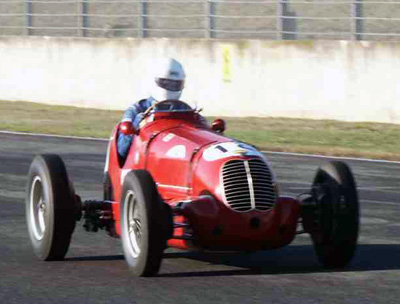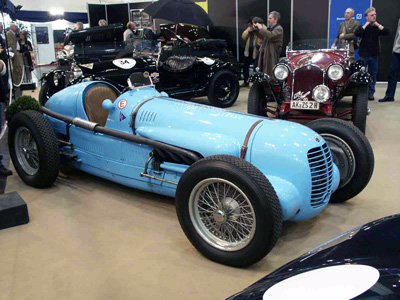
|
NOTE: You are viewing the OLD VeloceToday website. We are in the process of moving some of the old articles from the OLD site to the NEW site.
|

|

|

|


Home
Cars
Racing
News
People
Lifestyle
Events

|

|

|
Cars
|

|

|
May 26th, 2004
A Brief History of Maserati
by Pete Vack
Photos Copyright Alessandro Gerelli unless otherwise noted.

|
 The Maserati brothers built racing cars. While a few touring cars were
constructed during the 1930's, they were irrelevant to the firm. Here
in classic fashion, the Schollwoeck 6CM (Corsa Monoposto)is doing what was intended at Mugello.
The Maserati brothers built racing cars. While a few touring cars were
constructed during the 1930's, they were irrelevant to the firm. Here
in classic fashion, the Schollwoeck 6CM (Corsa Monoposto)is doing what was intended at Mugello.
|
All roads for Italian car companies eventually lead to Fiat. Lancia, Abarth, Alfa Romeo and others including Ferrari and now Maserati have come under the wing of the Fiat empire since the 1960s. Once bitter enemies, the assets of the Maserati car company were recently combined with those of Ferrari.

|
 There is a long story behind this Maserati. Suffice to say that it may
be one of the two or three 8C (two seat) 3000s built in 1930-31. Maserati did well in
Grand Prix events until the 750 KG formula of 1934. photo-Vack
There is a long story behind this Maserati. Suffice to say that it may
be one of the two or three 8C (two seat) 3000s built in 1930-31. Maserati did well in
Grand Prix events until the 750 KG formula of 1934. photo-Vack
|
The assets, of course, consisted of machinery, a factory, a design crew, production workers, but more than that, the purchase of Maserati ensured that the name would live on. It is a name revered in racing history, for Maserati has been building successful race and road cars since 1926.

|
 During this year's Mille Miglia, Gerelli captured an 8CM 3000 on film,
Driven by Kendall and George. The 8CMs, in 2800 and 3000cc, were very successful in Grand Prix racing from 1930-1934.
During this year's Mille Miglia, Gerelli captured an 8CM 3000 on film,
Driven by Kendall and George. The 8CMs, in 2800 and 3000cc, were very successful in Grand Prix racing from 1930-1934.
|
When There Were Seven
Ernesto, Bindo and Ettore were only half of a remarkable set of six sons born to Rudolfo and Carolina Maserati in Voghera, a small town outside of Piacenza. A seventh son, named Alfieri, was also born but died shortly after birth. The remaining six were all gifted, intelligent and industrious.
Mario Maserati was born in 1890, but unlike his brothers, was never interested in automobiles, and eventually became a painter. Carlo, born in 1881, was fascinated by the new internal combustion engine, and set the stage for his younger brothers. As a young man, Carlo worked for both Fiat and Isotta Fraschini. Carlo died when only thirty, but his interest in things mechanical had passed on to Alfieri, (who was given the same name as the baby who had died earlier). Bindo was born in 1883, Ettore came along in 1894 and Ernesto in 1898.

|
 Anglo American Whitney Straight ordered four new 8CMs in 1934 to compete in
European Grand Prix events. The shield shaped grille on this car tells us
it is one of the four Straight 8CMs, but which one? photo-Vack
Anglo American Whitney Straight ordered four new 8CMs in 1934 to compete in
European Grand Prix events. The shield shaped grille on this car tells us
it is one of the four Straight 8CMs, but which one? photo-Vack
|
Alfieri, Ernesto and Ettore established the Societa Anonima Officine Alfieri
Maserati in 1914, and although the initial intent was to prepare Isotta
Fraschinis for racing, the timing dictated that they make spark plugs for the
war effort. Maserati spark plugs would continue to be a staple for the
firm until the 1960s. After the hostilities, the brothers returned to the
modification of Isottas, which eventually led to the manufacture of a car of
their own design and construction. By 1926, the first Maserati, the Tipo 26,
was ready for the track. Alfieri, the mainstay and inspiration, died in 1932,
and Bindo stepped in to assist his brothers in running the business.

|
 To counter the German cars, the V8R1 was built for the 1935 season and
campaigned by Scuderia Subalpina, without success. This is s/n 4503.
To counter the German cars, the V8R1 was built for the 1935 season and
campaigned by Scuderia Subalpina, without success. This is s/n 4503.
|
The Maserati brothers found great success in Grand Prix and
Voiturette events throughout the 1930s. The Tipo 26 was followed by a series
of cars, with a variety of cylinders and displacements with different
nomenclatures. The 8C 1100, 1500, 2500, and 3000 were essentially the
same cars with different displacements. The 4CM (4 cylinders, Monoposto),
was built in small numbers with 1100, 1500, and 2500 cc displacement. The
Tipo V-5 was not a V-5 but a supercharged V-16, and the 6C series was used
in 1934. Four V-8 cars were built for the 1935 season. All told, a remarkable
range of engines, and an immense output of design and engineering.

|
 Maserati turned to the sports car races and voiturette class of 1500cc, and built eleven monoposto 6CM 1500s and sixteen 6C 1500s between 1936 and 1939.
Seen in the pits at the Nurburgring is Muller's 6CM1500.
Maserati turned to the sports car races and voiturette class of 1500cc, and built eleven monoposto 6CM 1500s and sixteen 6C 1500s between 1936 and 1939.
Seen in the pits at the Nurburgring is Muller's 6CM1500.
|
Like Alfa Romeo, however, the Maserati brothers could not compete with
the government-funded efforts of Mercedes Benz and Auto Union in the
latter half of the 1930s. This was offset, perhaps, by Wilbur Shaw's two
victories (1939 and 1940) at Indianapolis behind the wheel of an 8CTF
Maserati.

|
 As the 6CMs were very popular and many were built, many still survive in
great condition. This is Schollwoeck's, again at the Nurburgring.
As the 6CMs were very popular and many were built, many still survive in
great condition. This is Schollwoeck's, again at the Nurburgring.
|
The Maserati brothers were far too busy to write memoirs. We know very little about them. Ernesto, perhaps the most talented and aggressive, never had formal training as an engineer, yet had an amazing instinct for what was right. Ettore, called the "quiet one", managed the shop and all aspects of
construction, and on the side was very interested in viniculture. Of Bindo, we know less. The eldest, he tended to the business and administrative functions of both the Maserati works, and later the OSCA works. The cars they created, every one a hand-crafted masterpiece, say more about the Maserati brothers than any biography ever could.

|
 Maserati continued to try to compete with the German cars, and the fabulous
8CTF, a three liter supercharged car was the result. It failed in Europe but
won the Indy 500 in 1939 and 1940 driven by Wilbur Shaw.
Maserati continued to try to compete with the German cars, and the fabulous
8CTF, a three liter supercharged car was the result. It failed in Europe but
won the Indy 500 in 1939 and 1940 driven by Wilbur Shaw.
|
The Maserati brothers are perhaps the most significant part of the history of the company, for it was under their watch that Maserati race cars became famous around the world. They brought forth the legend, reinforced it with the names of Nuvolari, Varzi, Campari, Birkin, and Shaw, in an era when Enzo Ferrari was merely a driver and team manager for Alfa Romeo. They refused to build road cars, and there is only one recorded instance of a touring body on a pre-war Maserati chassis. They were fiercely independent and at the same time, unable to manage the business effectively enough to ward off bankruptcy.

|
 The ornate machining of the 4CLT is typical of the work of the Maserati
brothers. This is a 1947 model, but the car was essentially a pre war design.
The "t" stood for tubular chassis.
The ornate machining of the 4CLT is typical of the work of the Maserati
brothers. This is a 1947 model, but the car was essentially a pre war design.
The "t" stood for tubular chassis.
|
With the wolves at the door, the brothers Maserati sold all the assets, including their now-famous Maserati name, to Aldolfo Orsi. Under a 10 year contract, the brothers were retained to design and manage race car construction. But eventually the brothers found themselves as mere
consultants to the growing Orsi conglomerate. In 1947, as the renewal date approached Ettore, Ernesto and Bindo waited silently, not encouraging or asking for a new deal. The day came, and they left, relieved, but out of work. Within two years, the Maserati brothers would again be building race cars, this time under the name of OSCA. The three brothers thrived once again, and lived long and productive lives. Ettore died in 1990 at the age of 96, Ernesto passed away in May of 1975, and Bindo didn't even retire until he was 84!
|

|
|

|
|



